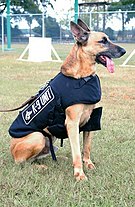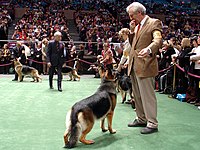| This Wikipedia page has been superseded by Portal:Dogs and is retained primarily for historical reference. |
| Note: Article entries are now being transcluded directly on the main portal page. However, this page should be retained for historical reference. |
Selected article 1
Portal:Dogs/Selected article/1
A dog breed is a group of dogs that have very similar or nearly identical characteristics of appearance or behavior or, usually, both, primarily because they come from a select set of ancestors who had the same characteristics. Dogs have been selectively bred for specific characteristics for thousands of years. Initially the selections would have centered on domestication and useful behavior such as hunting ability. Later, dogs were also selected for attractive and distinctive forms, resulting in a vast variety of types.Many traditional dog breeds recognized by the main breed registries are said to be "purebred". Only individuals whose parentage consists only of other purebred examples of the breed are regarded as part of that breed. This concept has caused controversy both because of the difficulty of regulation and because of the possible genetic consequences of a limited population (inbreeding). Recent work has been done to genetically classify the various breeds, with some surprising results regarding the estimated age and interrelations of the breeds.
Selected article 2
Portal:Dogs/Selected article/2
A puppy is a baby dog, generally less than one year of age. The term is sometimes abbreviated to pup, and in that form is used for the young of some other animals, such as the wolf. The number of puppies in a litter varies greatly by breed. Some smaller dogs typically bear only one or two puppies at a time, while some larger breeds bear a dozen or more. In some cases, one puppy will be the runt of the litter, being noticeably smaller than the others.Born after approximately 63 days of gestation, puppies emerge in an amnion which is bitten off and eaten by the mother dog. At first, puppies spend ninety percent of their time sleeping and the rest feeding. Puppies develop very quickly during their first three months, particularly after their eyes and ears open and they are no longer completely dependent on their mother. Puppies are highly social animals and spend most of their waking hours interacting with either their mother or littermates. It is important that the puppy receive regular positive socialisation with other dogs and humans during the first sensitive period (eight to twelve weeks).
Selected article 3
Portal:Dogs/Selected article/3 Laika (from Russian: Лайка, "Barker", as well as a name of a dog breed) was a Russian space dog that became the first living creature from Earth to enter orbit. She was found as a stray wandering the streets of Moscow. Originally named Kudryavka, she was renamed Laika after her breed type. After undergoing training with two other dogs, she was selected to be the occupant of the Soviet spacecraft Sputnik 2 and was launched into space on November 3, 1957.
Laika died a few hours after launch from stress and overheating, likely due to a malfunction in the thermal control system. The true cause of her death was not made public until decades after the flight. Some former Soviet scientists have since expressed regret that Laika was allowed to die.
Although Laika did not survive the trip, the experiment proved that a living passenger could survive being launched into orbit and endure weightlessness. It paved the way for human spaceflight and provided scientists with some of the first data on how living organisms react to spaceflight environments.
Selected article 4
Portal:Dogs/Selected article/4
A mixed-breed dog (also called a bastard, mutt (shortened from muttonhead), mongrel, tyke, mixed mutt, cur, or random-bred dog), is a dog that is a mixture of two or more breeds, or a descendant of feral or pariah dog populations. Except for extreme variations in size, dogs interbreed freely, mixed-breed dogs vary in size, shape, and color, making them hard to classify physically. Historically, all purebred dogs have been selected from a mixed-breed population. See Golden Retriever for an example.All possible body shapes, tongue color, ear types, and tail styles can appear in mixed breeds. Extremes in appearance, such as the flattened face of the English Bulldog or the extremely curled tail of the Pug, seldom survive even the first crossbreeding. Mixed breeds also tend to have a size between that of their parents, thus tending eventually toward the norm.
It's important to note that all dog breeds are man-made creations. Dogs were traditionally bred for specific functions. Most existing dog breeds began as mixed breeds, either by random occurrence or by deliberate crosses of existing breeds.
Selected article 5
Portal:Dogs/Selected article/5
Dog agility is a sport in which a handler directs a dog through an obstacle course in a race for both time and accuracy. Dogs must run off-leash with no food or toys as incentives. The handler can touch neither dog nor obstacles, except accidentally. Consequently, the handler's controls are limited to voice, movement, and various body signals, requiring exceptional training of the animal and of the human.In its simplest form, an agility course consists of a set of standard obstacles, laid out by an agility judge in a design of his or her own choosing on a roughly 100 by 100 foot (30 by 30 m) area, with numbers indicating the order in which the dog must complete the obstacles.
Courses are complicated enough that a dog could not complete them correctly without human direction. In competition, the handler must assess the course, decide on handling strategies, and direct the dog through the course, with precision and speed equally important.
Selected article 6
Portal:Dogs/Selected article/6
A police dog is a dog that is trained specifically to assist police and similar law-enforcement personnel with their work. They are also known in the United States as police K9s (a play on words; a homophone for canine).The term is sometimes also used in the common parlance of several countries to refer to any German Shepherd Dog because of the long history of the use of the German Shepherd by the police and military; in some nations German Shepherds are the only dogs used by those forces. Almost all dog breeds that are trained for police work originate from Germanic and Romance countries.
In recognition of the valuable role these animals play in police duties and the dangers they face, there have been a number of measures to ensure their protection. These include outfitting dogs with bulletproof vests to protect them from guns and some areas have passed laws that make attacking a police dog a felony.
Selected article 7
Portal:Dogs/Selected article/7
In a conformation show, judges familiar with specific dog breeds evaluate individual dogs for how well they "conform" to published breed standards. Conformation shows are also referred to as dog shows or breed shows. Conformation shows are typically held under the auspices of a national kennel club. At the highest levels are Championship or all-breed shows, which have separate classes for the majority of breeds. In addition, the show can be breed- or group-specific, usually organized by a breed club and often called a "specialty show".A conformation dog show is not a comparison of one dog to another. It is a comparison of each dog to a judge's mental image of the ideal breed type as outlined in the individual breed's breed standard. A judge chooses the dog(s) that most closely resemble the ideal on that particular day.
Usage
The layout design for these subpages is at Portal:Dogs/Selected article/Layout.
- Add a new selected article to the next available subpage.
- Update "max=" to new total for its {{Random portal component}} on the main page.
Nominations
Feel free to add featured or top/high importance articles to the list above. Other articles may be nominated here.





